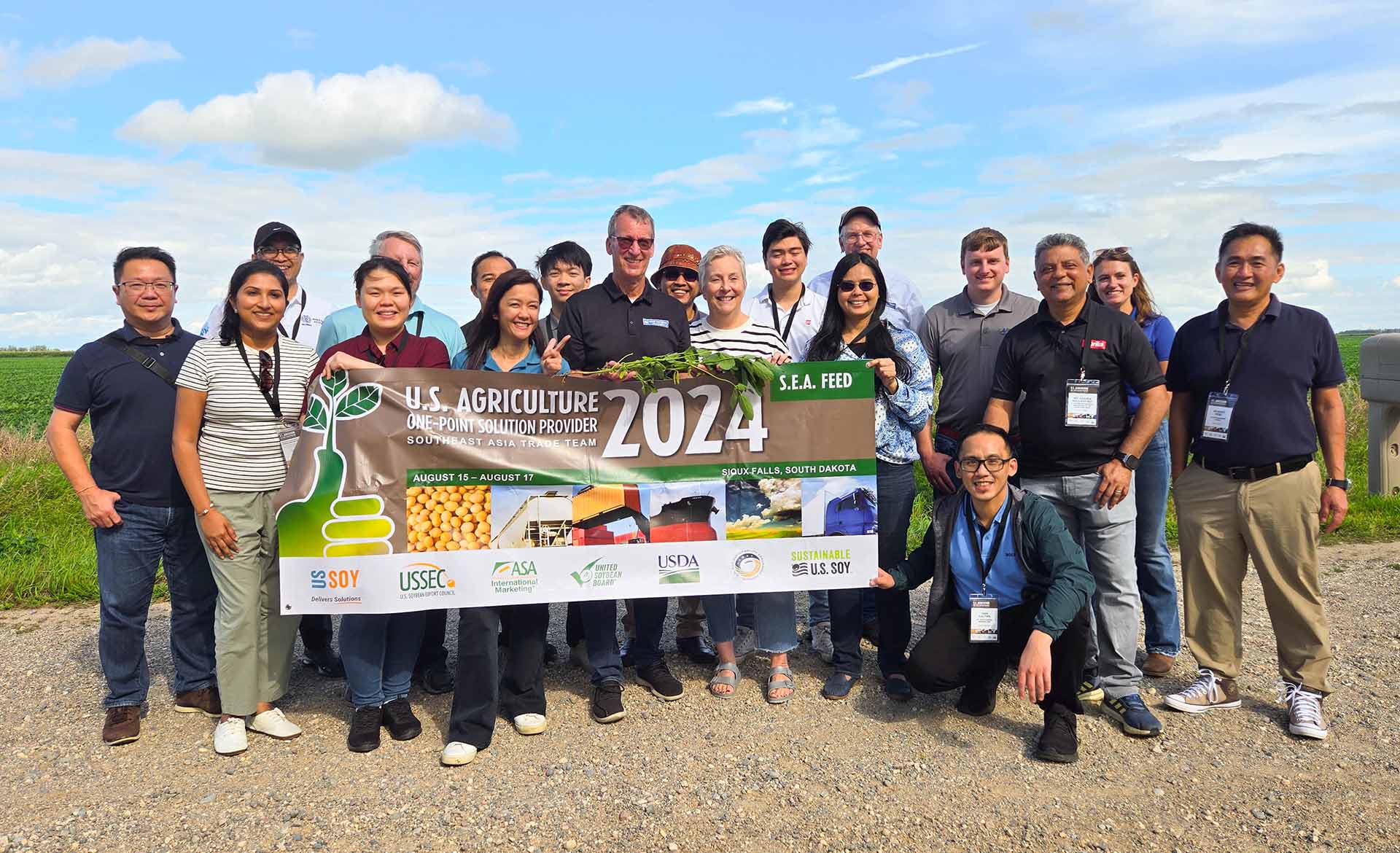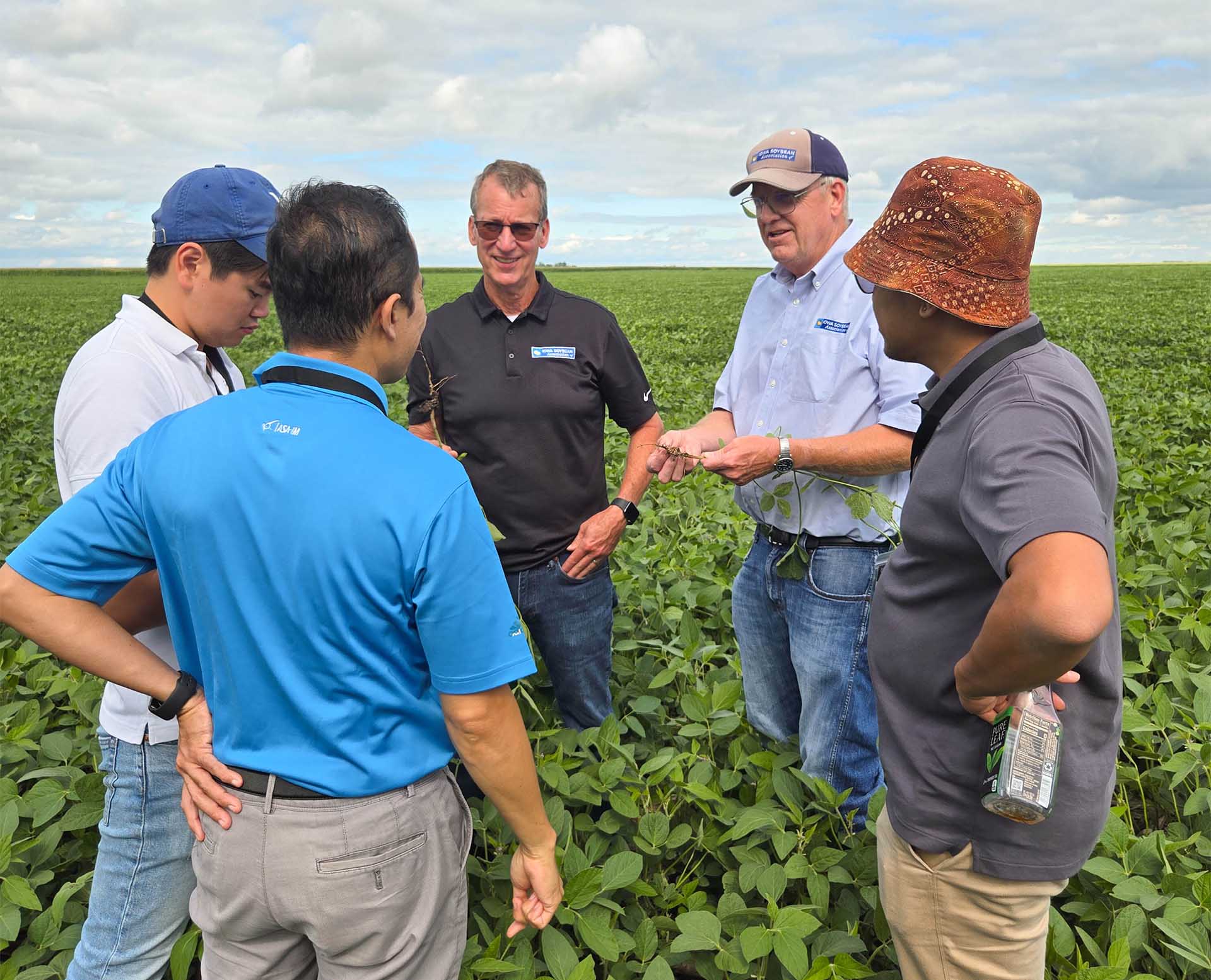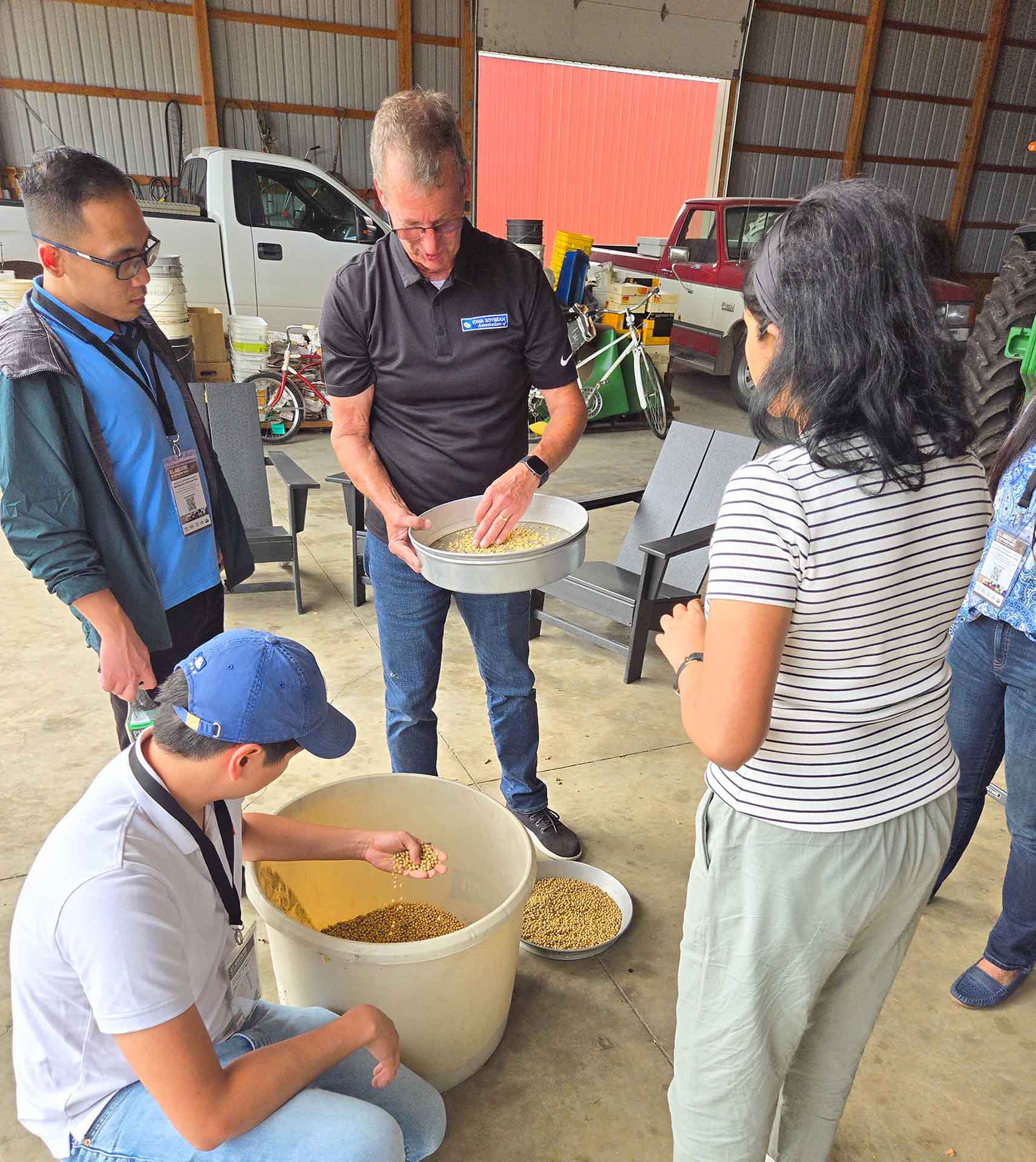
(Photo: Iowa Soybean Association / Kriss Nelson)
Showcasing quality and sustainability
September 5, 2024 | Kriss Nelson
USDA’s Outlook for U.S. Agricultural Trade report forecasts agricultural exports for fiscal year 2025 down $169.5 billion, down $4 billion from the revised forecast for fiscal year 2024. Soybean exports are projected to be down $1.5 billion to $22.9 billion. That is not good news for Iowa soybean farmers.
In an effort to help increase U.S. soy exports, organizations like the U.S. Soybean Export Council (USSEC) are working to help promote the United States as a sustainable and reliable producer and supplier of quality soybeans, soybean meal and soy products for food and feed applications through trade team visits.
USSEC recently organized a trade team visit with nine Southeast Asia countries to visit the U.S. before they attended Soy Connext, a global U.S. soy summit in San Francisco. It included a stop at Iowa Soybean Association District 1 director Paul Kassel’s farm in Clay County.
“It was exciting to meet people who are buying our U.S. soybeans,” says Kassel. “I enjoyed sharing my background and my farm and learning about their needs for soybean quality.”
These participants represented 40 companies from Australia, Indonesia, Malaysia, Myanmar, New Zealand, Philippines, Singapore, Thailand and Vietnam and collectively have annual import requirements of approximately 6.9 million metric tons of soybean meal, 5.2 million metric tons of commodity-grade soybeans and 10-15,000 metric tons of identity-preserved, variety-specific soybeans.
The trade mission members comprised integrated food processors, oilseed crushers, livestock raisers, aquaculture feed producers, soy food and beverage manufacturers and local and regional trading companies, thus allowing opportunities for networking and commercial trades of U.S. soybean and soy products.

A visit with a purpose
Gordon Denny, general manager of Gordon Denny, LLC, based in Brighton, Colo., was team escort for a portion of the group that visited ag industries and farms in South Dakota and Iowa. With a long history in the soy-crushing industry, Denny’s message to the trade team when it comes to buying U.S. soybeans was “more availability, lower prices and better quality.”
“No one does it better than the United States in terms of growing soybeans, as we do it in a very environmentally benign, safest way possible,” he says.
Two new soybean processing plants became operational in the past year, and one more is expected to start this year. Additionally, four more plants are expected to be operational in the next four to five months, with an additional two plants expected to begin next year. This represents a 20% increase in soybean processing capacity, equivalent to an additional 10 million metric tons of soybean meal entering the market.
Denny says with domestic soybean meal consumption only going up 1% or 2% a year, the U.S. needs to export that meal out of the country.
“We need to cater to Southeast Asian buyers,” he says. “Their expansion (of purchasing more soybean meal and soy products) will determine whether we run these soybean plants hard or shut some of the older plants down. Four or five plants could be in trouble if domestic and export soybean meal demand doesn’t dramatically pick up.”
Unfortunately, Brazil and Argentina are standing in our way.
“I am very concerned about Brazil's competition,” says Denny. “They out-export us in corn, soybeans, pork and poultry, and they have 40 million more acres to bring into production. U.S. agriculture is in for a rough go of it for a few years.”
During his explanation to the trade team members of the challenges faced by U.S. soybean farmers, Denny provided advice on addressing the challenges: "Construct additional poultry facilities, increase tilapia production, and promote higher consumption."
Representing QL Feed Sdn Bhd Feed from Malaysia was Cy Kwan, the company’s general manager.
QL Feed is a division of QL Resources where they import and distribute corn, soybean meal, DDGs and wheat to feed mills and farmers in Malaysia, Indonesia and Vietnam. Kwan says his company’s annual soybean meal usage is nearly 400,000 tons, with 20% used internally and the rest traded.
Producing 8.5 million eggs daily makes QL one of the largest egg producers in Southeast Asia.

“We use a lot of corn and soybean meal,” says Kwan, adding they prefer to purchase soybean meal from Argentina.
“It is cheap. Cheap in the sense of value. We have had issues with importing U.S. soybean meal lately due to container issues. The U.S. soybean meal quality is good; we have used it on our farm and sell it. Farmers like it. Somehow or another, we got a kick in the butt with delay and no containers.”
Kwan says he is hopeful U.S. soybean meal and soybeans will become more available and suitable for their market.
“USSEC says they have a technical team to give us support,” he says. “We thank them for inviting us to explore more and learn from you guys. We are seeing the real deal. Farmers need influence, and we hope to spread the good deeds and information on the United States increasing quality and reducing price. This is information we will take home to our customers.”
Robert Laovoravit, director at United Feed Mill Co., Ltd. in Thailand, says they are U.S. No. 1 yellow soybeans purchasers.
Laovoravit attended the trade team visit to better understand U.S. soy processing methods and the soybean conditions as Iowa farmers are heading into harvest.
“For us, quality is important,” he says. “As we see it, whether you are a big pig farmer or a small farmer, you really need the feed to work for you. That is our market, and we have always been about the farmer first.”
Vily Lim, senior trader, represented Soon Soon Oilmills Sdn Bhd from Malaysia, a diversified and fully integrated oilseeds, grains and oil processing company.
Lim says her company imports 450,000 to 500,000 metric tons of whole soybeans annually, with more than 60% coming from the U.S.
Customers at Soon Soon Oilmills are curious about sustainability. Lim visited the United States to see firsthand and better explain to her customers.
“I am impressed sustainably does happen at the farm level,” she says. “Gordon Denny has explained to us the benefits of U.S. soybean meal. I am quite impressed. The infrastructure is so well set up, and that helps bring quality product. The U.S. emphasizes quality, and we do not see that in South American soybeans. In terms of quality, from our perspective, U.S. soybeans are really good compared to Brazil.”
The Southeast Asia trade team was anxious to get into the soybean field.
“They were excited to learn about pod and plant development,” says Kassel. “I showed them the small, developing soybeans and how they will continue to fill the cavity in the pods. It was neat to see the excitement they had of our crop growing. They only see the finished product, not how it grows.”
Chuck White, a Spencer area farmer, also joined the team out in the field.
“What is grown here is the most pristine, perfect grain,” White showed the trade team. “You get No. 1 soybeans out of our fields. We look at the quality. And offer you the best quality of soybeans you can buy. We pride ourselves in growing a high-quality product for you.”
Back